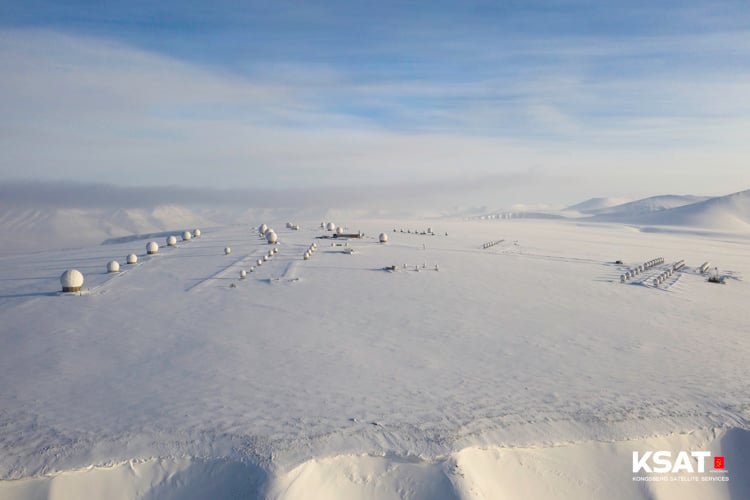At NTNU Small Satellite Lab, a multi-disciplinary team of master students, PhD-students and professors are currently working on a small satellite with a miniaturized hyperspectral camera for detection of toxic algae blooms along the Norwegian coast. KSAT will as part of this contract, provide commercial ground station services from the Svalbard Ground Station for this mission, called HYPSO-1. KSAT is well known for providing fast and reliable space to ground services. By using the unique ground station at Svalbard, KSAT ensures fast access to the time-critical data.
-We are very excited to get access to KSATs ground stations both at Svalbard and at other locations, says associate professor Egil Eide at the Department of Electronic Systems.
-HYPSO-1 will be part of a multi-agent surveillance system, operating both drones and surface vessels in near-real-time. It is very important to get data from as many satellite passes. This is an important strategic cooperation between NTNU and space industry, that will benefit students and researchers alike, Eide concludes.
Further the development of spacecraft engineering and related sciences
Kristian Jenssen is the director of KSATLITE, a division at KSAT dedicated to the development and delivery of scalable global ground station services for smallsats. The team are currently handling the major part of the commercial smallsats in orbit today, including some of the large constellations.
-I studied at NTNU myself and got the chance to be involved in a cubesat project. I find it rewarding that we can contribute to further development of space-related sciences in Norway, says Jenssen. He emphasizes that the students through these projects acquire unique hands-on experience, which is very relevant and thus valuable for KSAT as a possible future employer.
-It is important for us that students that want to delve into the discipline of spacecraft engineering and space related sciences, can get the chance to do so at Norway’s largest technical university.
Providing important information for commercial aquaculture industry
The small satellites in the HYPSO-project will be equipped with miniaturized hyperspectral cameras, that are able to “see” more than traditional optical sensors, covering parts of the infrared spectrum.
In combination with drones and autonomous vehicles both on surface and subsea, the goal is to be able to detect and alert the fish-farms about toxic algae blooms in the area. In 2019 a sudden upwelling of toxic algae killed close to 8 million salmon in Norwegian fish farms, wiping out more than half of the annual sales growth in just over a week. The hope is that with the contribution of this mission, one can avoid this in the future.
As a significant provider of maritime monitoring services KSAT had an active role during the algae bloom last year and together with partners in Tromsø they are currently exploring how to discriminate between different types of algae by combining different sensors and applying advanced algorithms.
- It is exciting with these new and small hyperspectral sensors. We support the project and believe it can provide a valuable contribution to future systems for algea warning and coastal monitoring to increase the understanding and support commercial aquaculture, says Kristian Jenssen.

KSAT will as part of this contract, provide commercial ground station services from the Svalbard Ground Station to ensure fast access to the time-critical data. (KSAT)
About NTNU Small satellite Lab
Small satellites is one of the strategic research areas at the Faculty of Information Technology and Electrical Engineering (IE) at NTNU. Through a cooperation between the Department of Electronic Systems (IES) and the Department for Engineering Cybernetics (ITK) as well as other actors at NTNU, the NTNU SmallSat Lab was established to carry out research, education, and development within the small satellite area.
HYPSO-1 is a 6-unit (10x20x30 cm) CubeSat, where the satellite bus is delivered by NanoAvionics in Lithuania. NTNU develops the payload and the operational use of the payload. The payload is a hyper-spectral camera, consisting of optics and a payload processor that assembles and processes the images from the camera before they are being downlinked through the KSAT network.
NTNU SmallSat lab also works together with the student organization Orbit NTNU, as student driven CubeSat project, which KSAT also has a cooperation with.
The HYPSO-1 project is financed by the Norwegian Research Council, NTNU AMOS, NTNU Oceans, the Norwegian Space Agency, ESA, EEA, the IE faculty, and the participating departments.
Top Image: Satellite images can be used to detect chorophyll and algaeblooms from space. Using current multispectral sensors like Sentinel, it has not been possible to differetiate between different types of algae. HYPSO-1, will have more spectral bands and the goal is to be able to detect toxic algae blooms. (©ESA/Processed by KSAT)
